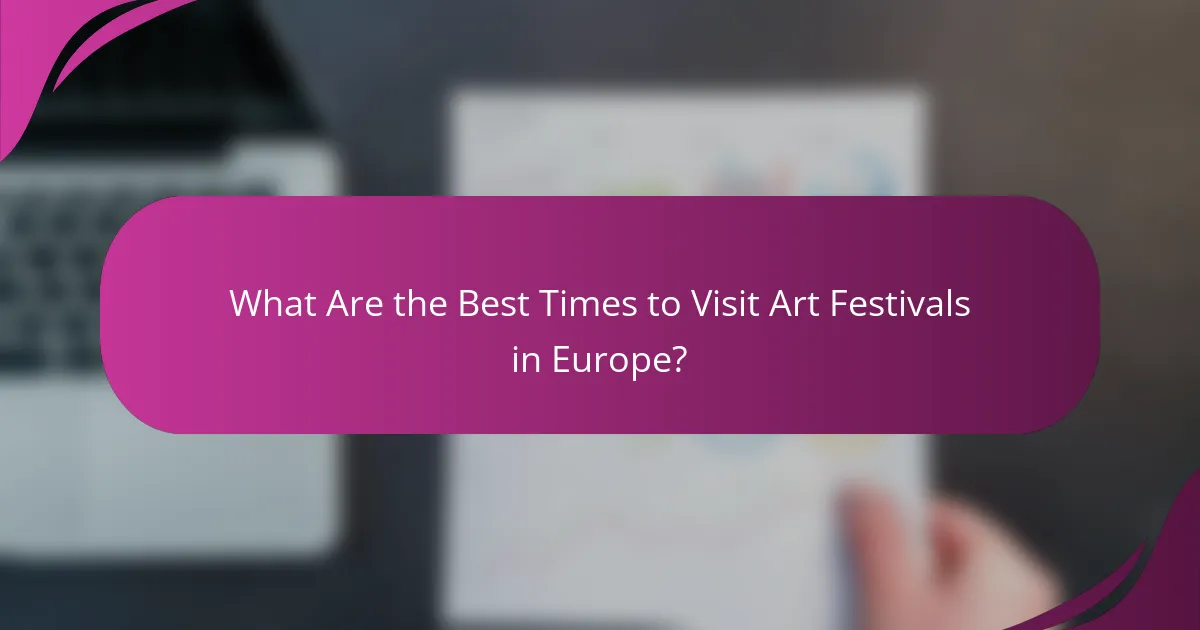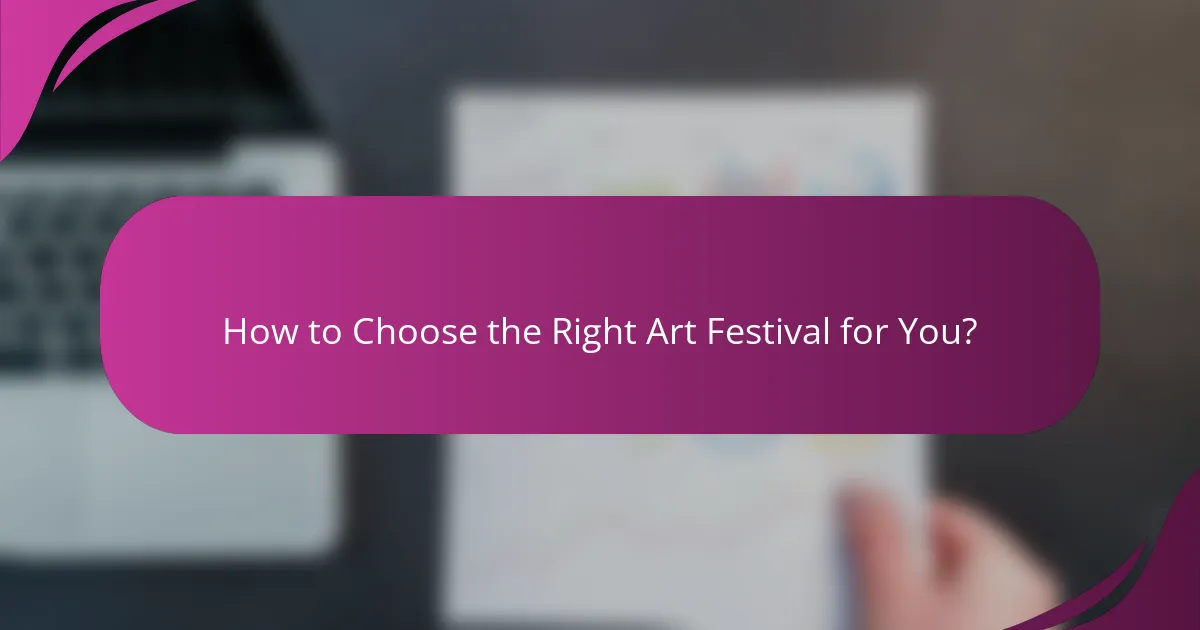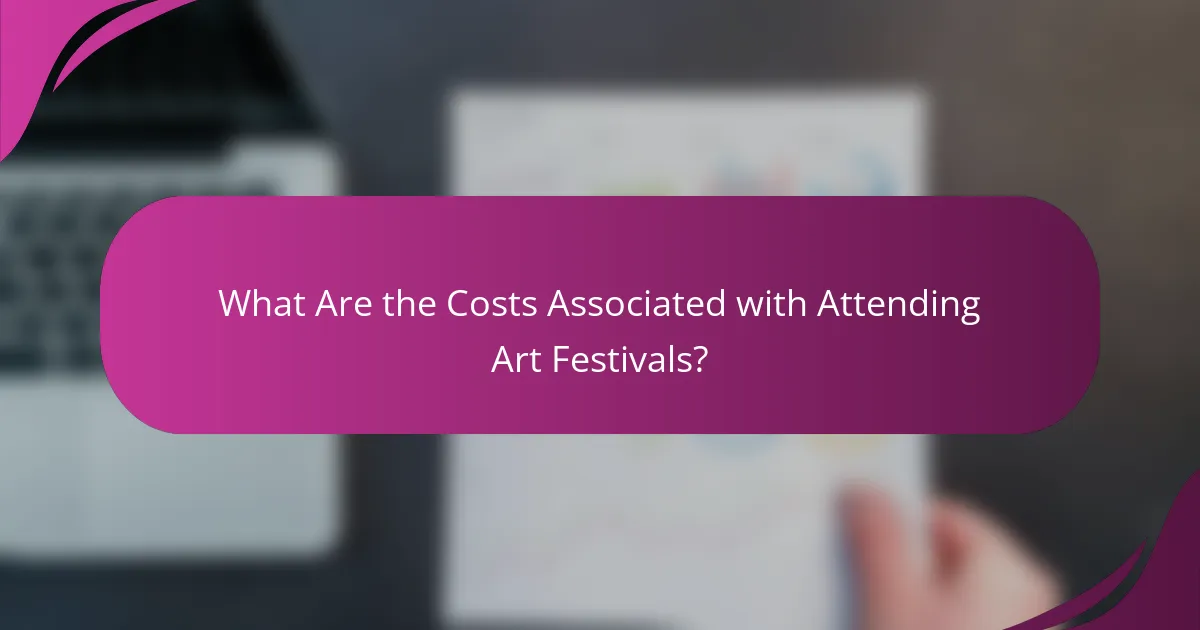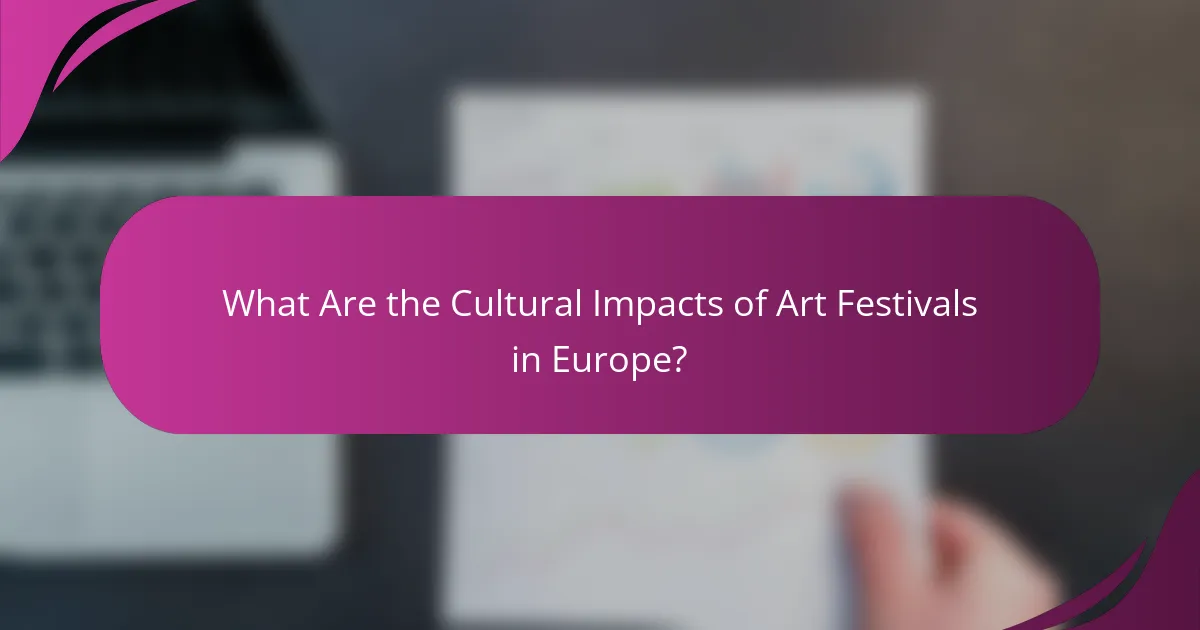Europe is home to several iconic art festivals that celebrate a rich tapestry of artistic expressions and cultural experiences. These events draw artists, curators, and art enthusiasts from around the globe, providing unique opportunities to engage with contemporary art and immerse oneself in the vibrant cultural landscape.
![]()
What Are the Most Iconic Art Festivals in Europe?
Europe is home to several iconic art festivals that showcase a diverse range of artistic expressions and cultural experiences. These festivals attract artists, curators, and art enthusiasts from around the world, offering unique opportunities to engage with contemporary art and culture.
Venice Biennale
The Venice Biennale is one of the most prestigious cultural events in the world, held every two years in Venice, Italy. It features national pavilions showcasing contemporary art from various countries, along with curated exhibitions and installations throughout the city.
Visitors can explore a wide array of artistic disciplines, including visual arts, architecture, and film. It is advisable to book accommodations well in advance, as the event draws large crowds, and ticket prices can vary significantly based on the exhibitions and events you wish to attend.
Edinburgh Festival Fringe
The Edinburgh Festival Fringe is the largest arts festival in the world, taking place every August in Edinburgh, Scotland. It features thousands of performances across various genres, including theater, comedy, dance, and music, making it a vibrant hub for creativity.
With a pay-what-you-can model for many shows, it offers accessibility to a wide audience. Attendees should plan their schedules carefully, as the festival spans the entire city and can be overwhelming due to its sheer scale.
Documenta
Documenta is a major exhibition of contemporary art held every five years in Kassel, Germany. It focuses on the latest trends and developments in the art world, often featuring groundbreaking works and thought-provoking installations.
Documenta encourages critical engagement with art and society, making it a must-visit for those interested in contemporary issues. Visitors should prepare for an extensive program that includes guided tours, lectures, and discussions to fully appreciate the context of the artworks.
Art Basel
Art Basel is a leading international art fair held annually in Basel, Switzerland, along with editions in Miami Beach and Hong Kong. It showcases modern and contemporary artworks from established and emerging artists, attracting collectors, galleries, and art enthusiasts alike.
Attending Art Basel can be a significant investment, with ticket prices and artworks often reaching high values. It’s beneficial to research participating galleries and artists in advance to make the most of your visit and network effectively.
La Biennale di Venezia
La Biennale di Venezia, often referred to as the Venice Biennale, is a major cultural event that includes the Venice Film Festival and the Venice Architecture Biennale. The art section, held every two years, features a rich program of exhibitions and performances from artists worldwide.
Visitors can expect a blend of traditional and avant-garde art forms. To navigate the extensive offerings, consider using the official app or guide, which provides insights into the various exhibitions and events taking place across the city.

How to Experience Art Festivals in Europe?
To fully experience art festivals in Europe, immerse yourself in the diverse offerings, from workshops to local installations. Engaging with artists and fellow attendees enhances your understanding and appreciation of the cultural landscape.
Attend Workshops and Panels
Participating in workshops and panels at art festivals allows you to learn directly from artists and experts. These sessions often cover various topics, including techniques, trends, and the creative process, providing valuable insights.
Look for workshops that match your interests, whether it’s painting, sculpture, or digital art. Many festivals offer sessions for different skill levels, so you can find something suitable regardless of your experience.
Explore Local Art Installations
Exploring local art installations is a key part of experiencing art festivals in Europe. These installations often reflect the culture and history of the region, offering a unique perspective on contemporary art.
Take time to wander through the festival grounds and nearby areas to discover temporary and permanent installations. Local artists frequently showcase their work, making it an excellent opportunity to support the community and engage with the art scene.
Participate in Guided Tours
Guided tours during art festivals provide structured experiences that enhance your understanding of the artworks and their creators. Knowledgeable guides often share stories and context that you might miss on your own.
Consider joining tours that focus on specific themes or styles, as they can deepen your appreciation. Check festival schedules for tour times and availability, as these can vary widely depending on the event.

What Are the Best Times to Visit Art Festivals in Europe?
The best times to visit art festivals in Europe typically align with the warmer months and specific biennale schedules. Summer offers a vibrant array of outdoor festivals, while spring is ideal for major biennales that showcase contemporary art.
Summer Months for Outdoor Festivals
Summer is prime time for outdoor art festivals across Europe, generally spanning from June to August. Cities like Edinburgh, Florence, and Berlin host numerous events that celebrate various art forms, including visual arts, music, and performance.
When planning a visit, consider attending festivals such as the Edinburgh Festival Fringe or the Venice Biennale, which attract large crowds and feature diverse programming. Be prepared for potential ticketing costs, often ranging from free entry to several dozen euros for premium events.
Spring for Biennales
Spring is the season for many significant biennales, particularly in cities like Venice and Berlin. These events typically occur from March to May and focus on contemporary art, providing a platform for emerging and established artists.
Attending a biennale can be a unique experience, as they often feature curated exhibitions and installations that change every few years. Be aware that tickets can vary widely, often costing between 15 to 30 euros, depending on the venue and special exhibitions.

How to Choose the Right Art Festival for You?
Choosing the right art festival involves aligning your personal interests with the festival’s offerings, size, and location. Consider what types of art resonate with you, how large a crowd you prefer, and how accessible the venue is for your travel plans.
Consider Your Artistic Interests
Your artistic interests will significantly influence your festival choice. Whether you prefer contemporary art, classical works, street art, or performance art, each festival has its unique focus. Research the featured artists and mediums to ensure they align with what you enjoy.
For example, if you are passionate about modern installations, look for festivals known for showcasing innovative contemporary artists. Conversely, if traditional art forms appeal to you, seek out events that highlight classical works or historical exhibitions.
Evaluate Festival Size and Scope
The size and scope of an art festival can greatly affect your experience. Larger festivals often feature a wider variety of artists and more activities but can also be overwhelming due to crowds. Smaller festivals may offer a more intimate atmosphere, allowing for deeper engagement with the art and artists.
Consider whether you prefer a bustling environment with thousands of attendees or a quieter setting with a few hundred participants. This choice can shape your overall enjoyment and the connections you make during the event.
Check Accessibility and Location
Accessibility and location are crucial factors when selecting an art festival. Ensure the venue is easy to reach, whether by public transport or car, and check for accommodations if you plan to stay overnight. Festivals in major cities may offer more amenities but can also be pricier.
Look for festivals that provide clear information on accessibility options, such as wheelchair access or transportation services. Additionally, consider the local culture and attractions, as these can enhance your overall experience during the festival.

What Are the Costs Associated with Attending Art Festivals?
Attending art festivals involves various costs, including ticket prices, accommodation, travel, food, and activities. Understanding these expenses can help you budget effectively and enhance your overall experience.
Ticket Prices for Major Events
Ticket prices for major art festivals can vary significantly based on the event’s prestige, location, and duration. Generally, you might expect to pay anywhere from €20 to €200 for a single-day pass, with multi-day passes often offering better value.
Some festivals also offer early bird discounts or group rates, so it’s wise to purchase tickets in advance. Keep an eye on the festival’s official website for any promotional deals or package options.
Accommodation and Travel Expenses
Accommodation costs can fluctuate widely depending on the festival’s location and the time of year. In major cities, hotel prices may range from €50 to over €300 per night, while budget options like hostels or shared accommodations can be more affordable.
Travel expenses will depend on your starting point and mode of transport. Consider booking flights or train tickets early for the best rates, and explore local public transport options to save on travel costs once you arrive.
Budgeting for Food and Activities
Food costs at art festivals can vary, with options ranging from street food at €5 to gourmet meals that may exceed €50. Setting aside a daily budget of around €30 to €70 for meals can provide a comfortable range for most attendees.
Additionally, factor in costs for activities like workshops or guided tours, which can add €10 to €100 to your overall budget. Planning ahead and researching local dining and entertainment options can help you manage expenses effectively.

What Are the Cultural Impacts of Art Festivals in Europe?
Art festivals in Europe significantly influence local cultures, economies, and community engagement. They serve as platforms for artistic expression, foster cultural exchange, and attract tourism, which can enhance the visibility of local artists and traditions.
Economic Benefits of Art Festivals
Art festivals can generate substantial economic benefits for host cities. They attract visitors who spend on accommodations, food, and local attractions, often leading to increased revenue for local businesses.
For instance, festivals like the Edinburgh Festival Fringe can bring millions of euros into the local economy, supporting jobs and stimulating growth in various sectors. Communities often see a boost in tourism during festival seasons, which can last long after the events conclude.
Community Engagement and Participation
Art festivals promote community engagement by encouraging local participation and collaboration. They often include workshops, performances, and exhibitions that invite residents to contribute and share their cultural heritage.
These events can strengthen social ties and foster a sense of belonging among community members. For example, festivals like La Fête de la Musique in France encourage musicians of all levels to perform, creating a vibrant atmosphere that unites people through shared experiences.
Promotion of Local Artists and Culture
Art festivals provide a vital platform for local artists to showcase their work, helping to elevate their profiles and connect them with broader audiences. This exposure can lead to new opportunities, collaborations, and sales.
Events such as the Venice Biennale highlight contemporary artists and cultural movements, often setting trends that resonate throughout Europe and beyond. By focusing on local talent, these festivals help preserve and promote regional cultural identities.